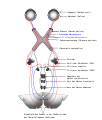Elektroftalm
The Elektroftalm is an invention of the Polish ophthalmologist Kazimierz Noiszewski , which was developed between 1897 and 1899. The arrangement served to give blind people the opportunity to perceive their surroundings and thus to increase their quality of life . The device simulates the outer part of the natural visual apparatus.
purpose
The arrangement served to give blind people the opportunity to perceive their surroundings. The blind becomes independent of the assistance dog , cane or guide for the blind.
development
Noiszewski's original arrangement consisted of a photoresistor as a sensor and an acoustic transmitter. Witold Starkiewicz further developed the device between 1960 and 1970 using a matrix of sensor cells and vibrator transmitters.
contraption
The Elektroftalm consists of:
- Camera
, the camera forming field of view on a matrix of 120 (10 lines with 9 - 12 element) from CdS - photocells from. - Control unit
The control unit converts the electrical values from the photocells into control signals for the transmitter unit. - Transmitter unit
The transmitter unit consists of a matrix of 120 electromagnetic vibrators that have been attached to a suitable location on the user's body. The inventor has made investigations into this. He found the forehead to be a suitable place for this giver.
Problems
device
- The CdS photo (resistance) cells are large and the response time depends on the light
- The energy requirement of the device is high and the possible storage volume is low.
- The matrix with 120 elements allows only a low resolution of the image .
Users
- It is necessary for the user to learn to transform the vibration signal into an image.
- The device is heavy.
gallery
Current developments
The development of semiconductor technology ( CCD sensor or Peltier element ), surgical techniques ( retina implant ) and medical research and methods such as implants and direct stimulation offer new approaches.
A completely analog technology was marketed between 1970 and the late 1990s under the name Optacon for recognizing characters. The camera and encoder were so small here that they could easily be moved over the documents and the vibration surface could be felt with a finger.
See also
Web links
literature
- Michał Pec, Paweł Strumiłło, Paweł Pełczynski, Michał Bujacz: O słyszeniu obrazów - systemy wspomagania osób niewidomych w percepcji otoczenia . In: SEP (ed.): Techniczno-Informacyjny Zarządu Łódzkiego . tape 35 , no. 6 , 2006, ISSN 1428-8966 , Stowarzyszenie Elektryków Polskich, p. 6-11 .
Remarks
- ↑ Kazimierz Noiszewski, b. September 11, 1859 in Vilnius, died July 5, 1930 in Warsaw, Polish ophthalmologist, lecturer at the Medical Military Academy in St. Petersburg, professor at the Stefan Batory University in Vilnius (Wilna) and the University of Warsaw
- ↑ Witold Szymon Starkiewicz, Pommersche Medical Academy, Szczecin (Szczecin)
Individual evidence
- ↑ Maciej Iłowiecki ,: Dzieje nauki polskiej (The History of Polish Studies) ( pl ). Wydawnictwo Interpress, Warszawa 1981, ISBN 83-223-1876-6 , p. 203: "Za Konstruktora pierwszego" oka elektrycznego "przeznaczonego dla osób niewidomych uchodzi również polski okulista Michał Borysiekiewicz (The inventor of the first" electric eye will also be "for be the Polish ophthalmologist Michał Borysiekiewicz) "
- ^ Słownik języka polskiego PWN - elektroftalm ( pl ) Encyklopedia PWN.
- ↑ Otto Beyer: Exposure and film development . Norderstedt: Books on Demand, 2014, ISBN 978-3-7357-4479-1 : “CdS light meters have [...] disadvantages. On the one hand [...] the memory effect. [...] In low light conditions, the CdS cells react rather slowly ”
- ↑ Heimarm semiconductor components for versatile applications . HIT-Karlsruhe,: "The rise and fall of a current in the CdS / Se photoconductor when switching lighting on and off is between 1 ms and a few seconds, depending on the illuminance, layer and doping"





